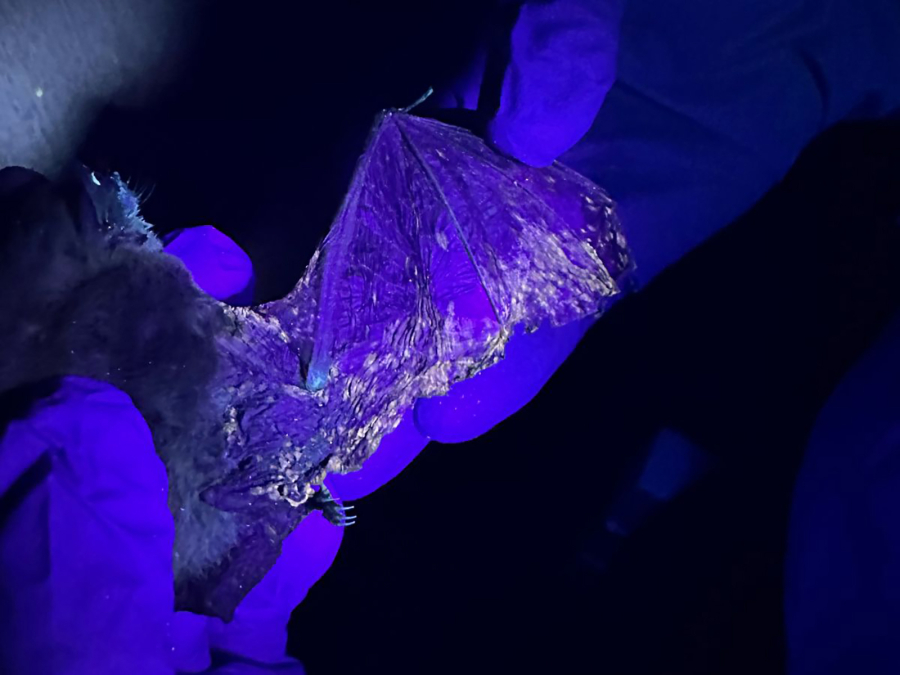


In addition to the enigmatic bugs and the mystery of the mushroom-frog relationship, another concerning development has been reported in Boulder County, Colorado. Two 'little brown bats' have been discovered to be infected with white-nose syndrome (WNS), a deadly disease caused by an invasive fungus. The first bat was found on a public bike path in Longmont on February 29 and was confirmed to have WNS after testing by Colorado State University. Two weeks later, a second bat in Boulder was also found to have WNS, indicating the potential for more infected bats in the area [09426ffb].
White-nose syndrome is a devastating disease that has killed millions of bats in North America. The fungus responsible for WNS has been confirmed in three 'little brown bat' summer roosts in Colorado, but this is the first time sick bats have been detected in the state. WNS was first documented in New York in 2006 and has since been found in 12 North American bat species. The fungus spreads from bat to bat, making it difficult to control its spread in the wild.
Colorado Parks and Wildlife (CPW) is concerned about the potential impact of WNS on the state's bat population. At least 13 of Colorado's 19 bat species are susceptible to the disease. Bats play a crucial role in the ecosystem by providing pest control services, contributing $3 billion annually to the U.S. agricultural economy. While the fungus that causes WNS does not infect humans or pets, it can be transported on gear or clothing that has been in contact with contaminated environments, including caves where bats hibernate.
To prevent the spread of WNS, CPW is urging the community to stay out of closed caves and mines, decontaminate gear before and after visiting caves, and report any dead or sick bats to CPW. These measures are crucial in protecting the bat population and preserving their important ecological role [09426ffb].
A bat infected with white-nose syndrome, a deadly fungus that has killed millions of bats across the country, was found in Longmont, Colorado. This is the second bat found with the syndrome in Colorado, indicating that the dangerous affliction is spreading. The bat was collected by a wildlife rehabber on February 29 and its infection was confirmed by Colorado State University. Another bat in Boulder also tested positive for the fungus in mid-March, suggesting that the fungus is spreading in that area. The fungus does not infect people or pets. The first little brown bat in Colorado with white-nose syndrome was found near Bent's Old Fort near La Junta. The fungus, which grows on bats' muzzles and wings during hibernation, causes infected bats to wake up more frequently and use more energy, leading to starvation before spring arrives. At least 13 of Colorado's 19 native bat species are susceptible to the disease. The spread of the fungus cannot be stopped in the wild, and any large-scale loss of bats could have negative impacts on Colorado's ecosystems and economy. To minimize the spread of the fungus, people are advised to stay out of closed caves and mines, decontaminate shoes and clothes worn while visiting caves, and report dead or sick bats to Colorado Parks and Wildlife [01617c09].
Colorado bats are facing multiple threats, including white nose syndrome, a deadly bat disease. Two bats with white nose syndrome were found in Longmont and Boulder. Colorado Parks and Wildlife has received more tips about dead or sick bats along the Front Range. Results of testing the bats for white nose syndrome are expected by mid-May. A 2021 study showed that three species of bats in Colorado declined by more than 90% within seven years of being exposed to white nose syndrome. At least 13 of the 18 bat species in Colorado are believed to be vulnerable to the disease. The loss of bats in North America could lead to agricultural losses estimated at more than $3.7 billion a year. Bats play a vital role in pest control, and their decline could impact Colorado's farms and forests. Wildlife biologists are monitoring bats and asking the public to report any sightings of active or dead bats. The public can also help by conducting surveys and reporting bat sightings. The fungus that causes white nose syndrome does not infect humans or pets, but it can be transported on gear and clothing. The U.S. Forest Service has implemented restrictions on cave access to limit the spread of the fungus. [480b9133]